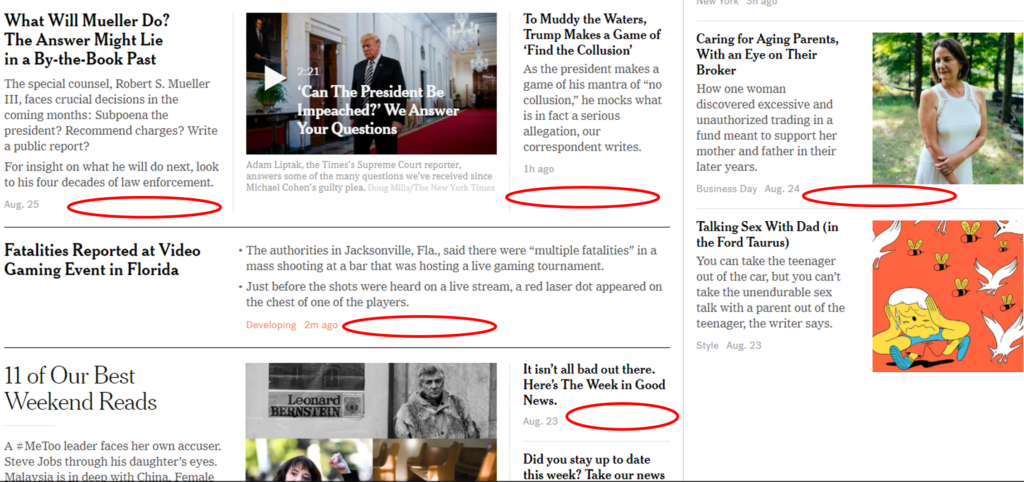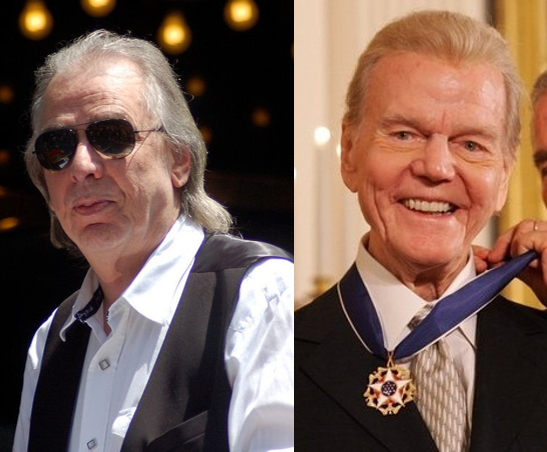
What do these names have in common?
Maggie Haberman, Peter Baker, Glenn Thrush, Michael Schmidt, Megan Twohey, Frank Bruni.
They’re all star reporters on the staff of the New York Times who are also frequently seen on cable news channels CNN and MSNBC. They’re like the morning shows of journalism. To many viewers, they have achieved celebrity status thanks to their investigative journalism, as well as their TV appearances on myriad talking heads segments where they analyze the events of the day – or the moment. Oftentimes, cable news lauds them for their reporting, breaking news stories, and all-out scoops. All have become multi-media personalities.
So, when the Times came out with its revamped homepage on both the web and on mobile – omitting reporter bylines – several noticed the apparent slight, including the host of “The 11th Hour,” on MSNBC – Brian Williams, who was bewildered by these missing identifiers.

This screen grab from Sunday’s Times home page shows these glaring omissions with helpful red ovals where those bylines should be.
What is the Times thinking?
In response to the “scores of readers” who have complained about this byline brouhaha, the Times’ executive editor, Dean Baquet, and managing editor, Joe Kahn, wrote an online explanation: “Where Did the Bylines Go? Times Editors Respond to a Home Page Question.”
They explain that while bylines are important and will remain in the physical paper, they are MIA on both the home pages of the web and mobile web/app. On the Times’s mobile assets, these reporter identifiers have been gone for “some time,” as both editors explain, leaving readers with the notion that perhaps no one complained.
Baquet and Kahn write that traditional bylines are “not always the best way to engage readers or display the most important elements of our journalism.” Clearly, the thinking is the lack of reporter identification makes for a cleaner, less “old school” look.
It’s also a mistake.

You can certainly ask the producers and editors at the aforementioned cable TV news networks. They are especially aware of which journalists at the Times, Washington Post, Wall Street Journal, Bloomberg, and USA Today (and that’s not all of them) ring the ratings bell when they appear on television.
And in the past couple years during the Trump Era, the identity of reporters, their stories, and their journalism have become important elements in following the larger story, in much the same way Woodward and Bernstein gained respect and recognition during Watergate.
There’s no doubt the Times is compensating this elite group of journalists well. So why hide them on the distribution platforms that are now far more popular than the print edition of the paper?
Sadly, aesthetics are obviously overshadowing common sense, leaving the Times in the awkward and even counter-intuitive position of stepping away from one of its key differentiators over other news outlets – the expertise, brilliance, credibility, and notoriety of its reporters.
During these crazy, over-saturated, media-rich times, personality and the trust factor mean more than ever. When you see a well-respected reporter taking responsibility for a story, there’s a sense of accountability at work. Most people have preferences for news reporters and anchors, whether on TV, radio, in print, or online. Seeing a reporter’s name or having it super-imposed below their image is one way consumers make judgments about a story’s veracity and whether they want to spend their precious time reading it.
That’s also true on the radio. We tune in talk or sports hosts because we like their style or points of view. We look forward to hearing a favorite DJ

tell us about the music we love because it brings a sense of richness to the experience. I remember hearing “I’m Jim Ladd, and we’re both listening to KMET” as communal enjoyment of rock n’ roll and what it represented. Or Paul Harvey turning commonplace news stories into fables and teaching moments because of his unique style, persona, and delivery.
Personality matters.
At a time when every news organization – whether it’s NPR, WTOP, or the BBC – is trying to set itself apart from the pack, this “cloaking device” by that bastion of journalistic excellence – the New York Times – is baffling.
It would be like leaving prominent DJs off a radio station’s home page, or worse, not allowing them to say their names on the air for fear of lengthier breaks that could create a “meter migration” in PPM.
Hey, let’s not give anyone any ideas.
Sign up for our free webinar – AQ: Radio’s First Talent On Talent Survey – in partnership with Talentmasters. It’s Thursday at 2pm ET. Details/registration here.
- Can Radio Afford To Miss The Short Videos Boat? - April 22, 2025
- Media And Technology In 2025: Believe It Or Not! - April 18, 2025
- In Radio, You Just Never Know - April 17, 2025




Lloyd Price – Personality, 1959 song on late 60’s …
https://www.youtube.com/watch?v=UmCZ_xzZsFQ